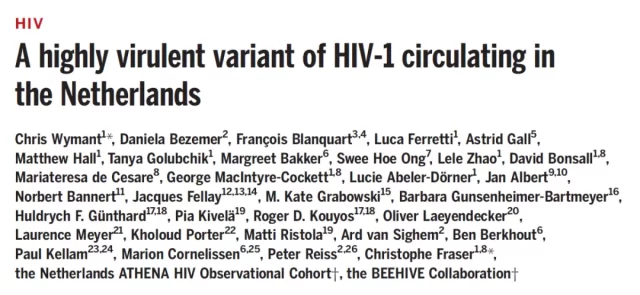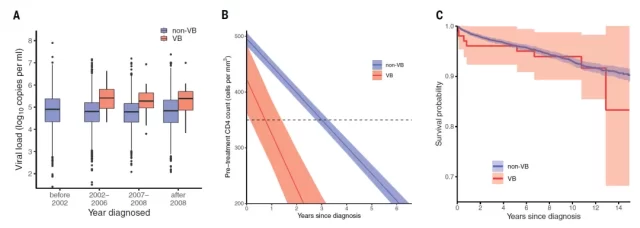A new highly virulent HIV strain (VB variant) discovered in the Netherlands
- Normal Liver Cells Found to Promote Cancer Metastasis to the Liver
- Nearly 80% Complete Remission: Breakthrough in ADC Anti-Tumor Treatment
- Vaccination Against Common Diseases May Prevent Dementia!
- New Alzheimer’s Disease (AD) Diagnosis and Staging Criteria
- Breakthrough in Alzheimer’s Disease: New Nasal Spray Halts Cognitive Decline by Targeting Toxic Protein
- Can the Tap Water at the Paris Olympics be Drunk Directly?
A new highly virulent HIV strain (VB variant) discovered in the Netherlands
- Should China be held legally responsible for the US’s $18 trillion COVID losses?
- CT Radiation Exposure Linked to Blood Cancer in Children and Adolescents
- FDA has mandated a top-level black box warning for all marketed CAR-T therapies
- Can people with high blood pressure eat peanuts?
- What is the difference between dopamine and dobutamine?
- How long can the patient live after heart stent surgery?
A new highly virulent HIV strain (VB variant) discovered in the Netherlands.
As demonstrated by the ongoing coronavirus SARS-CoV-2 pandemic, new mutations in the viral genetic sequence can have a major impact on the transmissibility and damage caused by the virus. For years, there has been concern about this happening with the HIV-1 virus.
According to UNAIDS statistics, HIV-1 has affected 38 million people worldwide and has caused 33 million deaths so far.
In a new study, a team led by researchers at the University of Oxford’s Big Data Institute in the UK has confirmed the discovery of a new, highly virulent strain of HIV called the VB variant in the Netherlands.
The results of the study were published in the journal Science on February 4, 2022, with the title “A highly virulent variant of HIV-1 circulating in the Netherlands“.

Before receiving antiretroviral therapy (ART), people infected with this VB variant showed marked differences compared with those infected with other HIV variants:
(1) The viral load of people infected with the VB variant 3.5 to 5.5 times higher amounts (the level of virus in the blood);
(2) In addition, people infected with the VB variant experienced a reduction in CD4 T cells (a hallmark of the damage HIV does to the immune system) than other HIV variants twice as fast, putting these infected people at faster risk of developing AIDS;
(3) people infected with the VB variant also showed an increased risk of transmitting the virus to others.
 Clinical features of individuals infected with VB variants.
Clinical features of individuals infected with VB variants.
Image via Science, 2022, doi:10.1126/science.abk1688.
Reassuringly, after starting treatment, immune system recovery and survival rates for people with the VB variant were similar to those for patients with other HIV variants.
However, the authors stress that the more rapid decline in immune system strength due to the VB variant makes it critical that infected individuals are diagnosed as early as possible and treatment begins as soon as possible.
Further research to understand the mechanisms that make VB variants more transmissible and damaging to the immune system may lead to the discovery of new targets for the next generation of antiretroviral drugs.
The VB variant is characterized by many mutations distributed throughout the genome, which means that a single genetic cause cannot be identified at this stage.
Co-corresponding author Dr Chris Wymant, from the University of Oxford’s Big Data Institute, said: “Prior to this study, it was known that the genetics of the HIV virus is linked to virulence, which means that the evolution of a new variant may alter its response to Health effects. The discovery of the VB variant demonstrates this, providing a rare example of the risks posed by the evolution of viral virulence.”
Co-corresponding author Professor Christophe Fraser, from the University of Oxford’s Big Data Institute, added, “Our findings underscore the importance of World Health Organization (WHO) guidelines that individuals at risk of HIV infection have access to regular testing so that early Diagnose , then treat immediately. This limits the time HIV can damage an individual’s immune system and compromise their health. It also ensures that HIV is suppressed as quickly as possible, preventing transmission to other individuals.”
The V B variant was first identified in 17 HIV-positive individuals in the BEEHIVE project, an ongoing study of samples collected from across Europe and Uganda. Since 15 of these people were from the Netherlands, the authors then analyzed data from a cohort of more than 6,700 HIV-positive people in the Netherlands. This identified 92 additional people from all regions of the Netherlands infected with the variant, bringing the total to 109.
By analyzing the patterns of genetic variation in these samples , these authors estimated that the VB variant first appeared in the Netherlands in the late 1980s and 1990s.
In the 2000s, it spread faster than other HIV variants, but since around 2010, its rate of transmission has been declining.
They argue that the VB variant emerged despite extensive treatment in the Netherlands, not because of this treatment, after all, an effective treatment can suppress transmission.
People infected with the VB variant showed typical characteristics of HIV-infected people in the Netherlands, including age, gender and suspected mode of transmission. This suggests that the increased transmissibility of the VB variant is due to properties of the virus itself, rather than the properties of virus carriers.
Reference:
Chris Wymant et al. A highly virulent variant of HIV-1 circulating in the Netherlands. Science, 2022, doi:10.1126/science.abk1688.
Joel O. Wertheim. When viruses become more virulent . Science, 2022, doi: 10.1126/science.abn4887.
A new highly virulent HIV strain (VB variant) discovered in the Netherlands
(source:internet, reference only)
Disclaimer of medicaltrend.org
Important Note: The information provided is for informational purposes only and should not be considered as medical advice.



